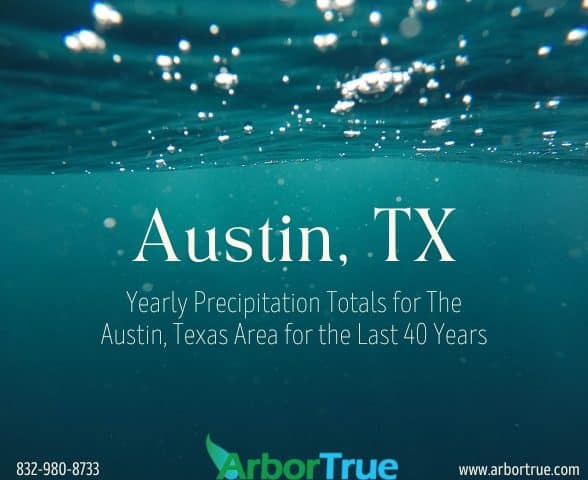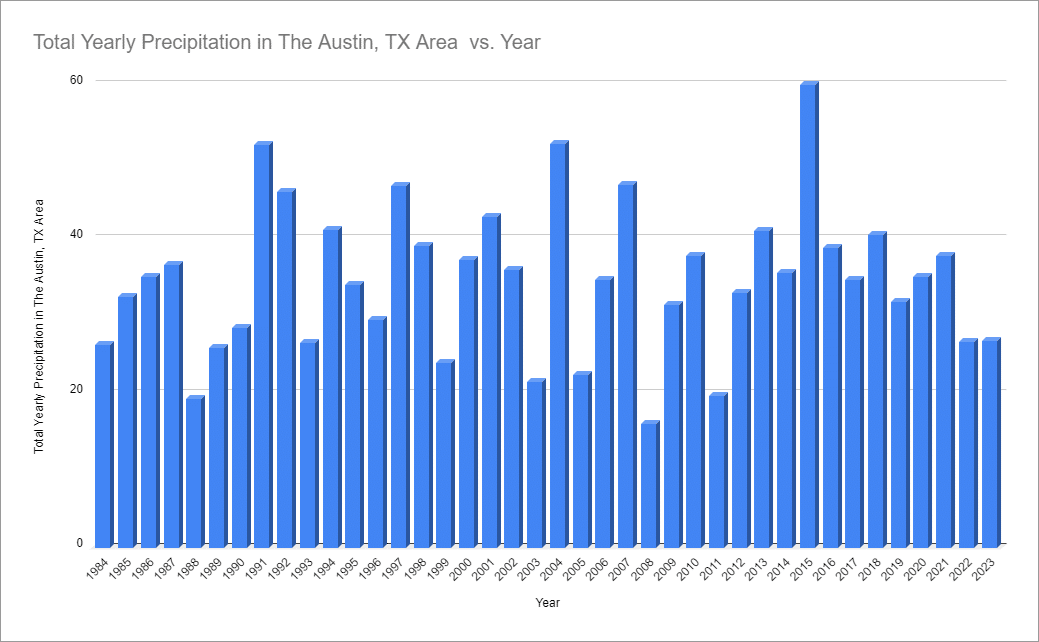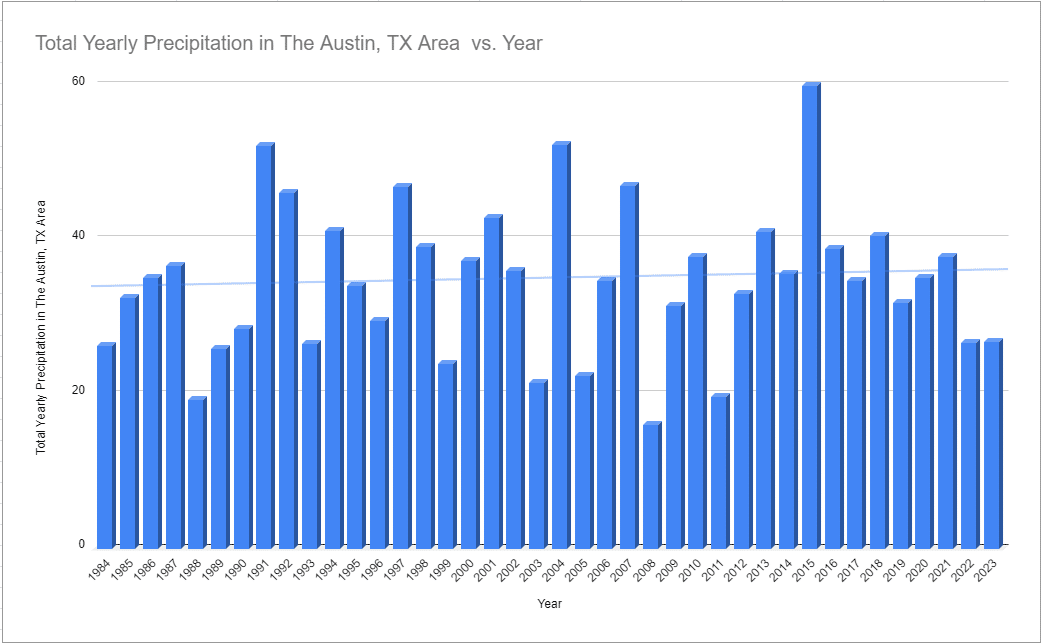
Average Temperatures in the Austin, Texas Area Over the Last 40 Years
May 15, 2024
Mushroom Monday: Wrinkled Peach Mushroom (Rhodotus palmatus)
May 20, 2024
Yearly Precipitation Totals for The Austin, Texas Area for the Last 40 Years
We thought we’d keep our focus on the climate with this post (in our last post we looked at temperature) and this time look at precipitation in the Austin, Texas area. For this post we looked at total yearly precipitation (in inches) for the Austin, Texas area over the last forty years (1984 – 2023).
The Data
Here are the yearly precipitation totals (in inches) for the Austin, Texas area for the last 40 years:
| Year | Total Yearly Precipitation in The Austin, TX Area |
| 1984 | 26.3 |
| 1985 | 32.49 |
| 1986 | 35.01 |
| 1987 | 36.66 |
| 1988 | 19.21 |
| 1989 | 25.87 |
| 1990 | 28.44 |
| 1991 | 52.21 |
| 1992 | 46.05 |
| 1993 | 26.5 |
| 1994 | 41.16 |
| 1995 | 33.98 |
| 1996 | 29.56 |
| 1997 | 46.79 |
| 1998 | 39.12 |
| 1999 | 23.93 |
| 2000 | 37.27 |
| 2001 | 42.87 |
| 2002 | 36 |
| 2003 | 21.41 |
| 2004 | 52.27 |
| 2005 | 22.33 |
| 2006 | 34.7 |
| 2007 | 46.95 |
| 2008 | 16.07 |
| 2009 | 31.38 |
| 2010 | 37.76 |
| 2011 | 19.68 |
| 2012 | 32.98 |
| 2013 | 41.03 |
| 2014 | 35.53 |
| 2015 | 59.96 |
| 2016 | 38.85 |
| 2017 | 34.72 |
| 2018 | 40.52 |
| 2019 | 31.86 |
| 2020 | 35.08 |
| 2021 | 37.73 |
| 2022 | 26.59 |
| 2023 | 26.83 |
Here’s the same data in graphical form:

Some Information from the Data
Looking at the data, there are few things that can be seen:
- The lowest precipitation amount was 16.07 inches and it occurred in 2008.
- The highest precipitation amount was 59.96 inches and it occurred in 2015.
- The median precipitation amount was 34.865 inches.
- The average precipitation amount was 34.59125 inches.
- 18 years had precipitation amounts below the average, and 22 years had amounts above the average.
- Three years had precipitation amounts less than 20 inches.
- Ten years had precipitation amounts greater than 40 inches.
- Three years had precipitation amounts greater than 50 inches.
- 27 years had precipitation amounts between 20 and 40 inches.
A Comparison to Houston, Texas
We previously looked at rainfall totals for Houston, Texas. Below is a graph of that data. It is one year off (1983 – 2022) and looks at rainfall (rather than precipitation), but provides an interesting comparison.

Some Questions
Looking at this data, there are some questions you might ask. They include:
- What caused the years with the three highest yearly precipitation amounts in the Austin, Texas area during the 40-year period (1991, 2004, and 2015)?
- What caused the years with the three lowest yearly precipitation amounts in the Austin, Texas area during the 40-year period (1988, 2008, 2011)?
- Why do the Austin precipitation totals seem less cyclical than the Houston rainfall totals?
- Is there a pattern in the Austin yearly precipitation totals?
Looking at the first question: (What caused the years with the three highest yearly precipitation amounts in the Austin, Texas area during the 40-year period (1991, 2004, and 2015)?)
In 1991, January and December had the highest monthly precipitation totals for those months for the 40-year period. January had 9.21 inches and December had 14.16 inches. The year seems to have started with a wet winter and ended with a wet winter. Six of the months during the year had above average precipitation amounts for those months for the 40-year period. In December, there was major flooding in the Austin (as well as San Antonio area) during 1991, and that contributed to the high total.
In 2004, again, two months had the highest monthly precipitation totals for those months. They were June, with 11.41 inches, and November, with 14.10 inches. Six of the months during the year had above average precipitation amounts for those months for the 40-year period.
In 2015, one month had the highest total for that month for the 40-year period. It was May, with a total of 17.59 inches. Seven of the months during the year had above average precipitation amounts for those months for the 40-year period.
Looking at the second question: (What caused the years with the three lowest yearly precipitation amounts in the Austin, Texas area during the 40-year period (1988, 2008, 2011)?)
In 1988, the highest monthly precipitation for the year was 3.33 inches. Eleven of the twelve months had precipitation totals less than three inches. Seven of the twelve months had less than two inches.
In 2008, something similar occurred. The highest precipitation total occurred in April. It was 3.52 inches. It was the only month that year to have three or more inches of precipitation. Eight of the months had less than two inches.
In 2011, again, it was similar. May and December had three or more inches of precipitation. Six of the months had less than one inch.
Looking at the third question, Why do the Austin precipitation totals seem less cyclical than the Houston rainfall totals?, this could be due to Houston’s proximity to the coast and hurricane events. Hurricanes and similar events are responsible for some of the high rainfall totals in the Houston area. This could account for the higher Houston totals and part of the cyclical nature of the totals. Something similar would occur from rain fueled by coastal moisture. These events wouldn’t have impacted Austin in the same way.
In the Houston data, three years are noted as particular years of drought. These were 1988, 1999, and 2011. Two of these three years correspond to years with the lowest precipitation totals in Austin (1988 and 2011). Although the droughts seem to coincide to some degree, the increased rain from Houston’s nearness to the coast could explain the difference in precipitation patterns.
In terms of the fourth question, Is there a pattern in the Austin yearly precipitation totals?, looking at the data with a trendline applied, it appears that the precipitation totals over time are fairly steady, and maybe slightly increasing.

The slope of the trendline is 0.05472514071. This means that, on average, over the 40-year period, Austin’s total annual precipitation increased by about 2.19 inches.
What Does This Mean for You and Your Trees?
All of this could mean a few things for you and your trees. Here are three possible insights:
First, the precipitation in Austin is quite variable. Some years have a lot of precipitation and some don’t. The same holds true for months. Some months have very little precipitation and some can have a lot. This isn’t something that is too predictable on any short-term basis. If you look at the monthly precipitation averages for each month over the forty year period, they aren’t very variable, ranging from 1.88 inches to 4.89 inches. This small range though doesn’t reflect the large swings that can occur in particular months.
Because of this, it would be wise to keep an eye on monthly rainfall totals if you live in the Austin area, and to adjust your watering to the needs of your trees. Keeping tabs on the rain that falls and adjusting things accordingly, can help your trees to do better.
Second, in addition to being variable, Austin’s precipitation can have extremes. Some months can have virtually no rain and some can have flooding. Although you can’t plan for all situations, planting the right trees, in the right places, at the right time of year, and in the right way, can help. An arborist can help you select native and other other trees that have better chances of tolerating the extreme precipitation swings in Austin.
Third, 92.5% of the years during the 40 years had precipitation totals greater than 20 inches. Although the precipitation totals for any month and year can be variable, there seems to be a general floor to yearly precipitation totals. This could be something to keep in mind when selecting trees for your landscape. It could help you pick trees that can generally tolerate those conditions and give you some idea of what supplemental watering might be required.
If you are interested in looking up other climate data for the Austin, Texas area, this site with climate data can provide you with some information.
If you are concerned about changes in the climate and how it affects your trees, you can reach out to us in the Austin area at (512) 546-3833 or email us at frontdesk@arbortrue.com to schedule an appointment.
If you found learning about precipitation in the Austin, Texas area interesting, be sure and check out our other TrueTreeTalk blog posts. Follow us on Facebook to keep up with these and other posts.
* * *
ArborTrue is a science-based tree-service company. We provide a range of services including tree trimming, tree pruning, tree removal, tree planting, arborist consultations, and more. Reach out to us online to schedule an appointment.




